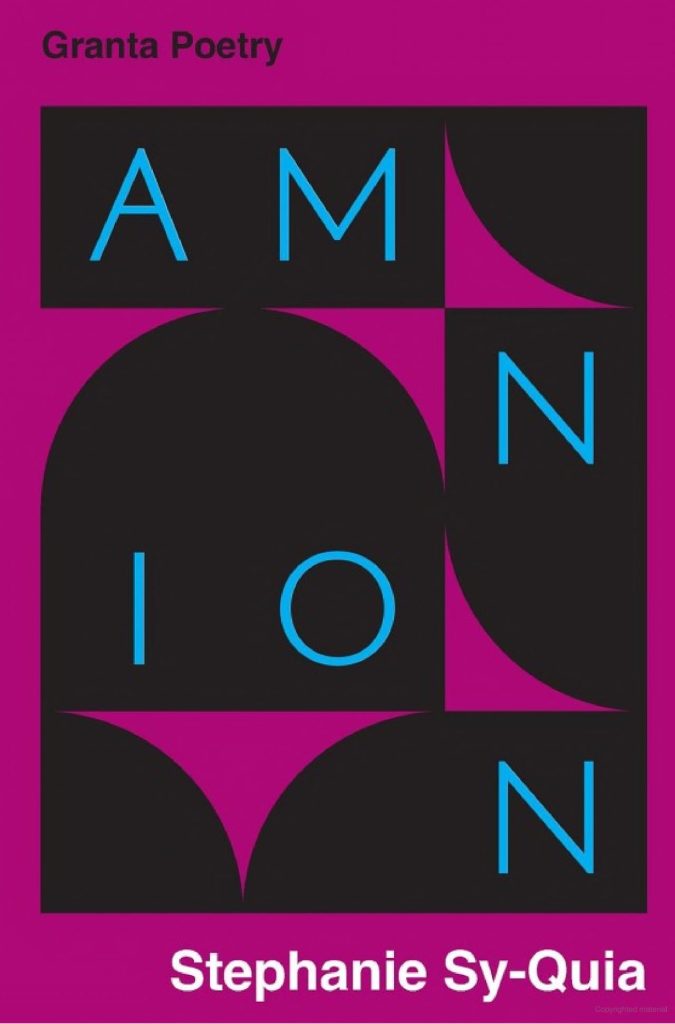Amnion (SHORTLISTED FOR THE FELIX DENNIX PRIZE FOR FIRST COLLECTION)
Stephanie Sy-Quia
(Granta Poetry, 2021); pbk; £10.99
Amnion is the membrane which protects an embryo during pregnancy. Amnion by Stephanie Sy-Quia thrums with potential energy. Although shortlisted for the Forward Poetry Award, it is fluid in form, moving between poetry, essay and autofiction. Biography serves as a throughline, as Sy-Quia traces back her lineage, across countries and generations, exploring how the actions of her great-grandparents reach into the present day. This is nothing so simple as a straightforward timeline, however. In this collection, the truth is suspect, time is flexible and the self is in flux, nebulous and ever-changing. Thus we have two central meanings in amnion (though others appear throughout the collection): the reference to family, to an embryo conceived by parents who were conceived in their turn; and to the self, both the writing self and personal self as a growing thing. Sy-Quia deftly explores culture, colonialism, and personhood with writing that is playful, brutal and challenging in turn.
The collection is divided into three parts, plus an epilogue. Part one, ‘Spandrel’, opens with two definitions of the word (which can refer both to the triangular space between two arches, and an evolutionary by-product not directly produced by natural selection), infusing the technical term with emotive power:
spandrel (church): shoulders, in part, an arch.
spandrel (biology): that which has not arisen from fear.
This section focuses on Sy-Quia’s family history. Sure enough, we learn that she and her family are the result of many courageous acts, most of them made by women. In these stories, the oppressive shadows of colonialism, class, religious convention and misogyny loom large. However, Sy-Quia resists any attempt from readers to categorise, fetishize or otherwise flatten her family into noble or tragic stereotypes by constantly throwing spanners into her own work. The poem ‘Summer 1986’, for example, opens with the statement ‘I lied’, and proceeds with a different origin story for her parents first meeting than the one told at the beginning of the collection. At other points this same interjecting, blunt persona challenges the reader directly, asking more than once throughout the collection: ‘shall I entertain you with the fetishism of a foreign name?’
With this self-referential style, Sy-Quia raises the question of the self. Is this a bildungsroman, the artist coming of age? Sy-Quia seeks to break such Euro-centric traditions, wary of making the collection ‘a cathedral for all my colonialisms’, a ‘museum’ for her parents’ misappropriated lives to be displayed and misinterpreted. Using the metaphor of the sphinx, murdered by ‘the successful uncoupling of her meaning from its shades’, she calls these ‘a slaughter of interpretations’,
so rightwing, pedantic
(masculine.)
Identity and art are further entangled in part two, ‘Narthex’, where Sy-Quia recounts her time in an English boarding school. A narthex is a physical entrance to a church building but not typically considered part of the church, so too this section deals with alienation, both from Sy-Quia’s classmates and her changing body, the latter impressed upon her: ‘My femalehood was boarded over my eyes like a set piece.’ A paradox emerges here in this collection: a search for self, in memoir and family history, yet Sy-Quia ‘sympathised with those spined creatures we split open on desks, / discerning their dispossessed’. There is no single meaning in this collection. It stands in defiance of the ‘church education’ which ‘will teach you that the monopoly of interpretation is / just’.
Part three, ‘Hapax Legomena’, brings us into the Brexit-afflicted present. But there is no neat conclusion: ‘My sentences, with their linearity, have duped you. / I am disrupting the categorising impulse.’ The reader is taken not journeying but wandering.
In the epilogue lies one final, tender twist, where Sy-Quia includes the corrections and comments of her parents and grandparents, going beyond self-referential, sharing the story with them. It is a story that resists narrative, too intricate to fit in a cathartic arc. Just as this collection and its writer could never fit in one review.
Kai Durkin


Leave a Reply